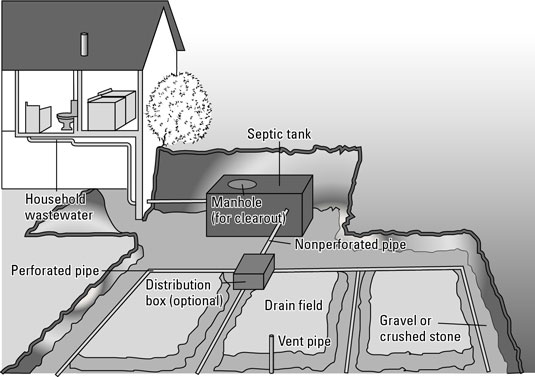Having a septic system for your home can definitely have its advantages, such as financial and environmental, but there’s also the responsibility of its routine maintenance. A septic system is either functioning properly or it’s not, with no in-between.
Which means that your home can’t afford to have a septic tank design that will cause overflowing, resulting in a costly and messy cleanup. To help maintain the proper functions for your septic system, here are a few simple ways make sure that it stays healthy.

Inspect Your Tank Yearly
Checking your septic tank yearly can show if it needs to be pumped more often or less. Also, be sure to inspect the drain field areas for odors, wet spots or any rising sewage. You can inspect the septic tank yourself or have a septic tank professional check the levels to see whether your tank needs to be pumped more or less frequently.
Try to Conserve Your Water
Septic tanks have limitations and can handle but so much water at a time. This is because septic tanks need time to separate the solid waste from the liquid waste, then send the liquid waste to the drain field. But the less wastewater produced, the less wear and tear on your tank. To prolong your tank’s usage and prevent an increased chance of system failure:
- Make sure you check for any running water coming from your toilets and/or leaks from your faucets.
- If possible, consider installing a low flow or high efficiency toilets.
- When doing laundry, try to conserve your water by choosing the most efficient load size that will save the most water.
- Try spreading out your laundry days so that you allow for your septic tank to recover.
- Maximize dishwasher loads
- Take quicker showers with less water consumption
Keep Your Tank Protected
It’s essential that your septic tank stays protected from the inside and out. To maintain your tank’s protection, adhere to these guidelines:
- Keep any and all heavy-to-the-ground items away from your tank and drain field. This includes things such as parked cars or heavy vehicles(R/V), cement, asphalt, sheds or above ground pools. Heavy items such as these can and will damage the tank, the pipes and compact the soil around the drain field; which compromises the effectiveness of the drain field.
- Do not plant any gardens or trees, and do not construct any buildings near the septic system without consulting with your local health department first.
- Do not install a garbage disposal with a septic tank. If you do, use it sparingly. Garbage disposals can clog your drain field which creates more waste water. Having a garbage disposal also means yearly septic tank pumping.
Do not allow these items to enter into your septic system:
- Fats or grease
- Motor oils and/or fuels
- Disposable diapers
- Coffee grounds, egg shells and nut shells
- Bones/Celery
- Filter tip cigarettes
- Paints or chemicals
- Napkins, paper towels or rags
- Tampons or condoms
- Cat litter
- Cotton swabs
- Dental floss
Don’t poison your septic system/tank by putting these any of these items into it:
- Drain cleaners
- Floor cleaners
- Toilet bowl cleaners
- Paints solvents
- Waxes, polishes, or coating
These harmful chemicals have the potential to destroy the important bacteria in your septic tank and contaminate the surrounding ground and surface water areas.
Use Environmentally and Septic–Safe Products
- Use dish, hand and body soaps that are environmentally and septic safe for your tank.
- Use toilet paper that is septic-safe.
- Flush with “RID” and/or pour a liter of spoiled buttermilk in your toilets every 2-3 months. These work as good bacteria for your septic tank.
Get a Hydrostatic Pressure Gauge
To prevent any water from entering into your basement due to an overflow to your septic tank or an uneven flow from the drain field, you will need a hydrostatic pressure gauge. A hydrostatic pressure gauge measures the amount of hydrostatic pressure that’s flowing through your septic tank system, as well as against the foundation of your house.
This gauge also allows you to check the water pressure levels in and around your septic tank and drain field, along with the foundation surrounding your house to ensure that pressure levels are normal. Too much pressure can cause water from your septic tank to overflow and eventually seep into the cracks and gaps of your basement.
Check to See If Your Septic Tank Needs Pumping
There are four important factors to consider when deciding how frequent you should pump your septic tank:
(1) Household size,
(2) Total wastewater generated,
(3) Volume of solids in wastewater, and
(4) Septic tank size.
Typically, your septic tank should be pumped every 1-5 years.
Your septic tank has a T-shaped outlet that keeps sludge from leaving the tank, flowing towards your drain field. If your tank needs pumping it will show in one or two ways: (1) The bottom of the layer of sludge is within six inches of the bottom of the outlet, or (2) if the top of the sludge layer is within 12 inches of the outlet.
When it’s time to have your septic tank pumped, don’t forget to have it inspected as well; having it inspected while being pumped ensures that your entire septic system is functioning properly.